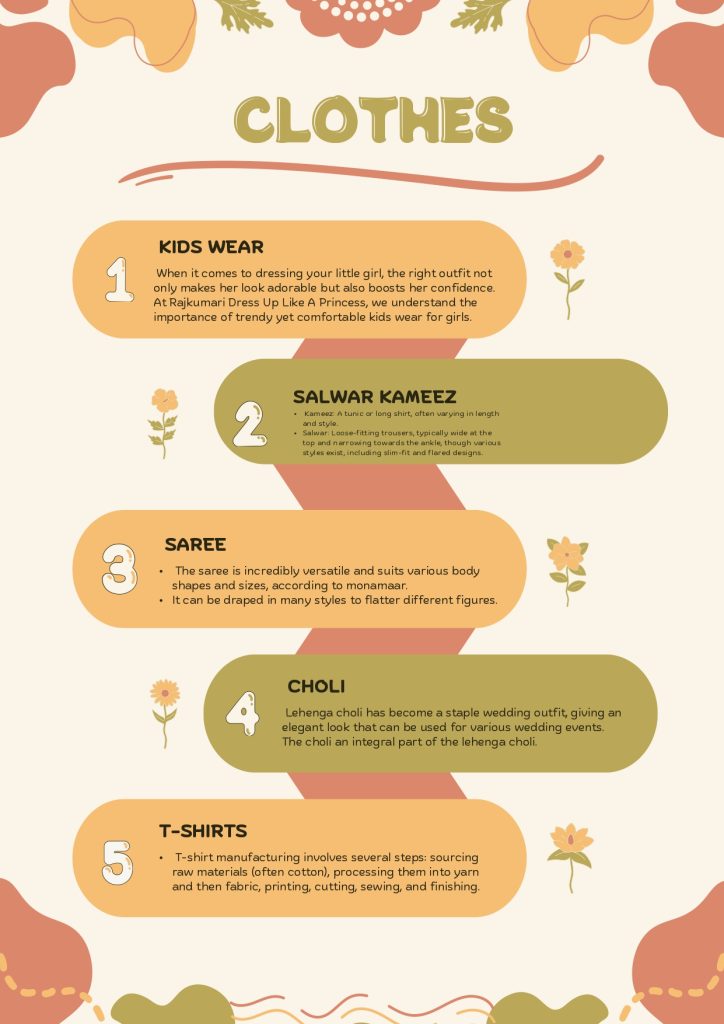Clothes

What is the importance of clothing?
Clothing is essential for production from environmental elements and hazards, comfort, hygiene, and to meet social and cultural needs,, including expressing identity, cultural heritage, modesty, and professionalism. Clothing provides a physical barrier between the body and the environment, allowing people to survive in diverse climates while also fulfilling deeper psychological needs for self-expression and belonging.
What are details in clothing?
Garment details include many elements such as seams, buttons, zippers, pockets, pleats, and embroidery. These details not only serve functional purposes, but also contribute significantly to the visual appeal and overall design of a garment.


Factors to consider when choosing a polo shirt color
- Skin tone: Fair skin tones pair well with bold colors, medium tones with earthy shades, and dark tones with bright colors.
- Personal preference: Choose colors that make you feel confident.
- Wardrobe: Select colors that easily integrate with your existing clothes.
- Season: Lighter colors are suitable for warm weather, and darker colors for cooler seasons.
- Occasion: Opt for classic colors for formal settings and bolder choices for casual outings.
Purposes of clothing
Purposes of clothing
- Protection: Clothes shield us from various elements like heat, cold, rain, dust, wind, UV radiation, and insect bites. They also offer protection against injuries from rough surfaces or sharp objects, and can serve as a hygienic barrier in certain professions.
- Modesty and social norms: Wearing clothes is a variable social norm, reflecting standards of modesty and decency in most societies.
- Identification and belonging: Clothing can signify membership in a group, culture, religion, or profession, fostering a sense of belonging and helping individuals differentiate themselves. Uniforms and traditional attire are examples of this.
- Social Status: Clothing has historically served as a marker of social status, wealth, and power, with specific garments or luxurious materials used to communicate social standing.
- Self-expression and aesthetics: Clothing allows individuals to express their unique personality, creativity, and aesthetic preferences through styles, colors, textures, and accessories.
- Comfort: Choosing appropriate clothes based on weather and activity enhances physical comfort, while certain fabrics and designs offer benefits like breathability, insulation, or absorbency.

How to describe clothing: 6 simple tips
- Use clothing to show status and position.
- Build (or thwart) expectations using clothing descriptions.
- Describe clothing to contrast character personalities.
- Show clothing to avoid over-relying on telling.
- Change clothing to highlight character development.
How many types of clothes are there?
There isn’t a fixed number for types of clothes, as they can be categorized in numerous ways, such as by purpose (formal, casual, work, activewear), demographic (menswear, womenswear, children’s wear), garment type (dresses, shirts, pants), fabric type (cotton, silk, wool, linen), or even by style (streetwear, classic, punk).
What is clothing in simple words?
Clothing is what your wear, like sweaters, shirts, pants, dresses, and so on. Your favorite piece of clothing might be your purple polka dotted tights. Clothing is made of fabric and covers our bodies, keeps them warm or protects them from the sun, insects, sharp rocks and thorns, and other hazards.
clothing in short information


visit again
- Contact us :
- Address :
- Email id :
- websites :